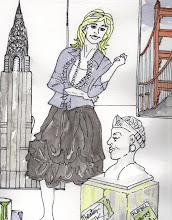Traveling in a foreign country? Do what the locals do, goes the adage. One option for discerning the quotidian is a deep dig on the website of the Undersecretary for Public Affairs for the Department of State. Or you may prefer just to watch people walk. Focusing on just this one attribute - how the natives go about "walking" - will help you gauge potential culture shock during your journey. Unlike any number of other cultural markers, peripatetic behavior illustrates the spirit of a people, unconsciously. Already arrived at your destination? You can examine the headlines of local newspapers, see which books are featured in store windows, talk to a bartender, and queue up where theater performances have the longest lines. Or you can just take your ease on a park bench, and watch the natives walk by.
Of course, in some countries, walking is the primary form of transportation. Attempts at recreational walking are a sure sign of progressive dementia in third-world regions and will garner you a wide berth by the saner citizens. On the flip side - in over-developed countries - some urban walking is recreational, and some walking is transportation in its purest form. In a large urban metropolis where walkers pepper the streets and the parks in generous numbers, walking is viewed as a marker of adaptability. Walkers can easily outpace taxicabs and town-cars locked in metallic embrace at the edges of cross-hatched ("don’t block the box") intersections in Manhattan.
Truly,walking praxis is a microcosm of a country’s culture. Don't buy it? Let's take a look at walking behavior in the United States, the United Kingdom, France, and Germany.
In the U.S., most walking is accomplished by running, or by alternating walking and running. Or in the case of American mall walkers, by rapidly flapping ones arms so as to make the upper half on one’s body appear to be running while the bottom half tries frantically, but unsuccessfully, to keep up. Even casual Americans dress for the occasion; there is the ubiquitous pony-tail pulled through a hole in a baseball cap, flagrantly advertised name-brand sweats, and running shoes so technically advanced that they come with software. Male walkers in the U.S. tend to go it alone; in fact, they tend to rollerblade. But the women walk in multitasking pairs, combining exercise with a steady breathlessness praddle, due in even measure to exertion and the exchange of confessional narrative. There is everywhere the sense that the walk must be accomplished as quickly as possible.
There is long history and elaborate, polite protocol for most everything that is accomplished out-of-doors in the United Kingdom; the British make no exception for walking. When walking in England, one is nearly always required to be in the company of a Corgi and to carry a carved walking stick that looks like it could subdue the wildest sort of Scotsman rushing down from untamed moors. The weather is usually and steadily dismal in England, and most months call for wearing something tweedy or a Macintosh. The result is that everyone outside of London appears to be dressed for a healthy constitutional, Royals not excepted. When a Brit invites you to join them on a walk, they may use the word amble. But this innocous sounding word, means something decidedly different to the British than it does to the rest of the world. A Sunday amble can entail an earnest look-see from the top of a swelling summit. A Brit, exhibiting characteristic stoicism interlaced with bottomless cheeriness under the most adverse circumstances, will undertake a hearty scramble up cloud-hidden, craggy regions inhabited by seemingly feral sheep when the weather is the most savagely wet and windy. One can readily see that the fun of an amble, then, is the stark contrast to a walk to market.
Nearly everyone has heard that the health and figures of French women benefit immensely from all the walking they do through the course of a day. The French have an appreciation for the art or the evolution of a thing – the lecons de choses or lessons from things - and they have made an art out of walking. A walk in Paris begins with a step onto the boulevard, but soon devolves into a series of pleasant, if choreographed, interruptions through which one must steadfastly hold to the original intent of the walk. Taking a walk in one’s arrondissement offers expected encounters with the butcher, the baker, the greengrocer, the cheese seller; each vendor wants to know how their item was received. How did your guests or your family receive the dinner? Did you prepare it as instructed? If your ambitions include doing a few errands while walking, you'll need to run the gauntlet quickly if you are to finish in time to cook dinner. Except that, what the French do not do is run. By all reports, the only regular joggers on the streets of Paris are the riot police and U.S. expats. Except, occasionaly in the spring, after a very cold and trying winter, protesting students can be seen running from the disciplined Parisian riot police who have duly logged their laps.
Any discussion of walking in Germany will, quite obviously, need to include the Volksmarch. Walkers formidable enough to stroll into the interior of Central Park would do well to emulate Volksmarch aficionados. Pick one big guy to carry a very long pole; decorate it, if you must. This designated leader is charged with the grave responsibility of keeping all the folk together and safe; pass the leader at your peril (He will not hesitate to use the decorated pole.). And, so that bystanders will clearly recognize the collective nature of this exercise, everyone must wear the same Steirerhut, preferably of loden green boiled wool with a small but jaunty red feather tucked under the hatband. The Germany fondness for poles – which extends to the giant (not that size matters) Maypoles erected in villages across Bavaria on May 1st – is further in evidence by the use of (Nordic) walking sticks. These otherwise intrepid marchers, click-clocking their poles along on a path as flawless as post-Zamboni rink ice, must fear some danger lurking in the Jurassic-Park environs; they shuffle along the undulating ribbon of asphalt in herds. As the marchers are out of range of careening wayward cars from the autobahn, the only other probable danger in this sparsely settled land is wild animals or lightening. Just maybe, in the short history of the Volkmarch, rabid wild boars have swarmed down from the forest edge and overrun folk who either let down their guard or were completely jolly due to the many rest stops at local breweries. I'm told there are more wild creatures in the Black Forest than just cuckoos. On the Palatine jura, marchers can see – and be seen - for virtually miles. A volksmarch leader’s pole is the tallest thing on open ground for miles. My bet is on lightening strikes. Perhaps the tradition should be relaxed a bit; that pole could be lowered and carried horizontally. Upon reflection, I wonder if the processions I've witnessed really were Volksmarchs. They reminded me quite a bit of scenes in a Monty Python film. Maybe the huddled groups were simply stealing Maypoles from neighboring villages? If that was the case, seems like it would have been more expedient to drop the log in a long bed Chevy and peel rubber.
Sunday, October 18, 2009
Subscribe to:
Post Comments (Atom)








No comments:
Post a Comment